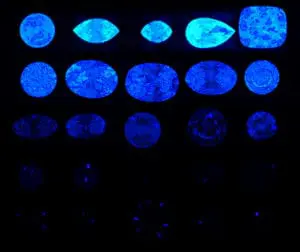Michael D. Cowing FGA
AGA Certified Gem Laboratory
email: michaelgem@gmail.com
Abstract: Decades after the establishment in the mid-twentieth century of ultraviolet-free illumination for colour grading a diamond, an examination of diamond trade and laboratory grading practices finds nearly everyone employing some type of fluorescent tube lighting containing significant ultraviolet. This paper demonstrates and quantifies the over-grading of blue-fluorescent diamonds that often results. Simple methods are proposed that, by themselves or in combination, provide inexpensive and workable solutions to resolve this problem.
Where is the proof of the over-grading of many blue-fluorescing diamonds? Quoting Tashey (2009): “I was shocked when I made the initial discovery, by placing a clear, UV filter, plastic film between the Verilux lamps in the GIA DiamondLite and the diamonds to be graded, that stones with very strong blue fluorescence could change to a lower colour by three or four letter grades.” He spoke of a 0.89 ct marquise brilliant with ‘Very Strong Blue’ fluorescence: “In the DiamondLite [Verilux lamps, without UV filter] this stone was graded table down as a high ‘D’. … When viewed table down, with the UV filter between the lamps and the diamond, the colour grade of the diamond shifted to that of a low ‘H’.” Tashey (2000) had earlier found that diamonds with ‘medium’ to ‘strong’ blue fluorescence generally shifted one to two colour grades when the filter was used.
Tashey’s discovery is an example in a ‘Very-Strong-Blue’ fluorescing diamond of close to a four and a half grade colour improvement to high D in the DiamondLite from its unimproved colour grade of low H. This large an improvement caused by blue fluorescense may be met with disbelief by professionals in the trade, all of whom grade in some form of UV-containing fluorescent illumination. Consequently they have not witnessed this large a shift in colour. However, the data base in the current investigation contains a 0.63 ct marquise diamond with a similar four and a half grade improvement in the DiamondLite over its unimproved colour as determined in typical artificial lighting. Most forms of artificial light including that from fluorescent tubes overhead at a distance of two to three or more feet contain negligible UV at the diamond’s viewing position. The diamond’s colour unimproved by blue fluorescense is seen and graded in this lighting.
Documented evidence of the over grading of blue fluorescent diamonds was present in a photograph in the paper “The effect of blue fluorescence on the appearance of diamonds. Gems &Gemology, 33(4), 244–59 by Moses et al. (1997). Their Figure 3 includes a set of six diamonds graded I colour in the DiamondLite, which were said to differ only in their fluorescent strengths. These identically colour graded diamonds reproduced in Figure 2 show clear face-up colour differences.

Figure 2: Six diamonds graded I colour in a DiamondLite showing a range of fluorescence. Picture reproduced courtesy of GIA; these three photographs were used in the assembly of Figure 3, I colour set pictured in the paper by Moses et al., 1997, p. 249.
The photograph was taken in incandescent illumination (Erica Van Pelt, pers. comm.,) which by its nature was essentially UV free (less than 1 μW) at the subject distance. This compares to the over 170μW of grade whitening UV present within a 2 inch grading distance in the DiamondLite. This photograph affords an opportunity to see the relationship of the colour differences, apparent in the face-up diamond images, to their fluorescence strengths. The fluorescent strengths, from left to right, are: 1 Medium, 2 Very Strong, 3 Faint, 4 Strong, 5 None and 6 Strong. Stones 2, 4 and 6 appear to have substantially more colour than the other three in spite of all having been graded as I colour. It is no coincidence that these more tinted diamonds are the three with the strongest blue fluorescence.
The substantial face-up difference in for example the right most two diamonds is easier to compare in the combined image of the same upper-right halves of those two diamonds where the sizes of each half are matched while preserving the colour difference between the diamonds as they appeared in the Gems and Gemology article’s Figure 3.

Combined image of two diamond halves showing the body color difference absent stimulation of fluorescence of a None (whiter lower left half) and a Strong Blue fluorescent diamond (darker upper right half), both having been graded the same I color in the DiamondLite.
Revealed in the photographer’s relatively UV-free lighting is the darker colour unenhanced by blue fluorescence of the three strongly fluorescing members of this I colour set.
From GIA’s research study, this photography provides visual proof of the overgrading of these three diamonds relative to their colour unimproved by blue fluroescence.
While the difference is apparent, the magnitude of over-grading relative to the colour unenhanced by fluorescence cannot be accurately determined from this photograph. That quantification of color difference was accomplished in this study by grading and analysis of the 25 diamond data base central to this investigation.
25-Diamond Fluorescence Study Data Base.

Click to download the pdf: The Over Grading of Blue Fluorescence Diamonds – Published in “The Journal of Gemmology” / 2010 / Volume 32 / No. 1–4